Agapi from Poland Finds Expression in the Art...
A Polish-born artist who lives on...
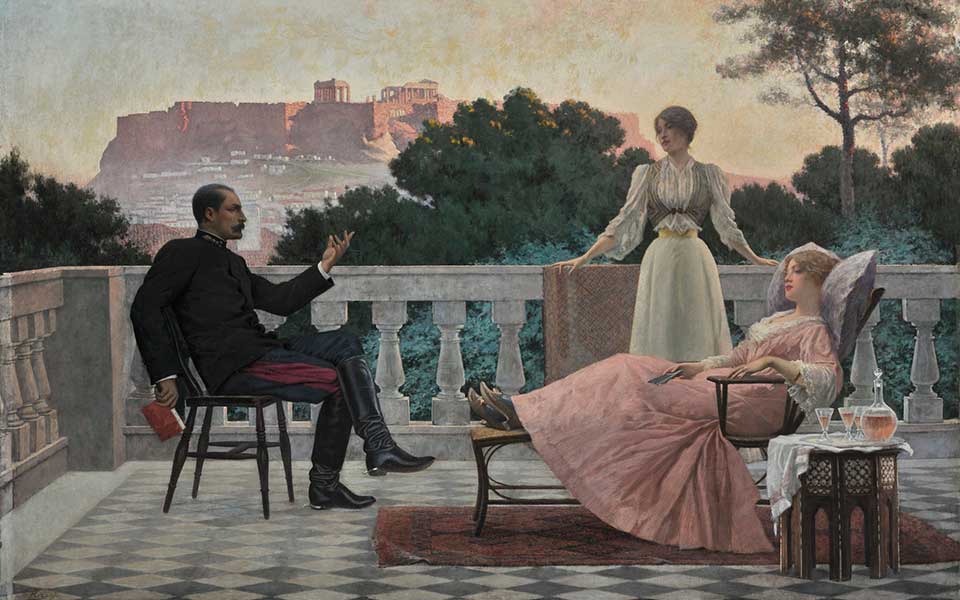
Iakovos Rizos, On the Terrace 1897
This large, sumptuous canvas, now returned from the Louvre after the 2022 exhibition “Paris-Athens, The Birth of Modern Greece, 1675–1919,” has an illustrious history, having won the silver medal in the 1900 Paris World’s Fair. It offers the National Gallery’s most detailed depiction of aristocratic Belle Époque Athens: a veranda at sunset, a carafe and delicate glasses of refreshment on an ornate table, the Parthenon glowing in the distance, and fashionable young women in cultured attire, contrasted by the sharp uniform of a handsome cavalry officer.
Positioned on the left, his dynamic pose and the striking contrast of his black uniform against the softer hues around him suggest he is the scene’s protagonist, gesturing to engage the ladies. Though there may be flirtation in the air, the women’s expressions are more reserved – perhaps a product of their era’s etiquette, or perhaps the lingering heat, which even as dusk falls, remains oppressive.
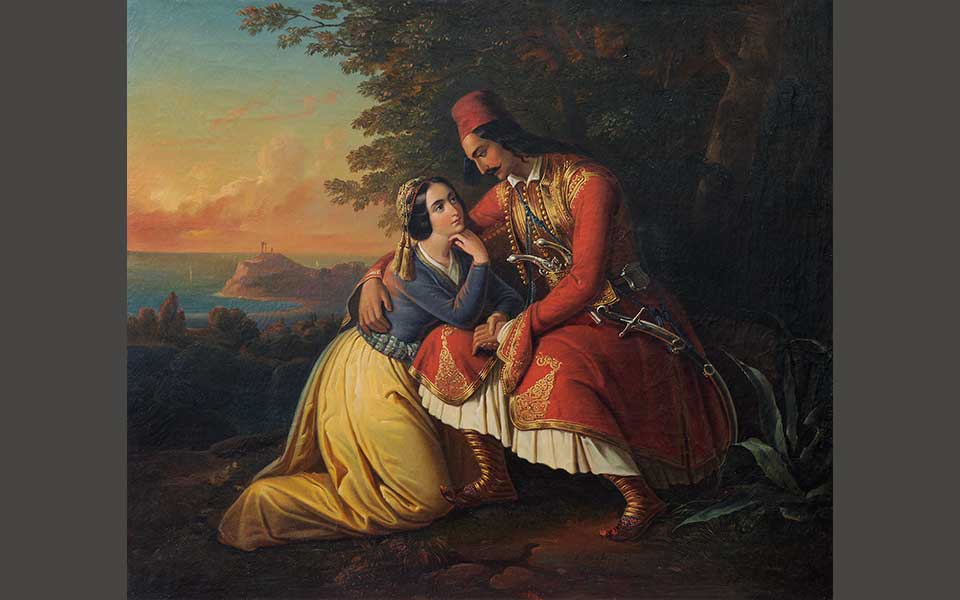
Farewell at Sounion, 1863, Theodoros Vryzakis
Vryzakis’ works stir the patriotic soul, reflecting his own story, which mirrors the history of Modern Greece. He was touched directly by the revolution, as his father was killed by the Ottomans in 1821. Later, he attended the Panellion in Munich, a school established by Ludwig I for orphans of the Greek war for independence, where he began to paint. He was accepted at the Munich School of Fine Arts, where he was trained in the western academic style. Vryzakis traveled to Greece from 1848 to 1851 to study the landscape and people in his desire to depict key events of the revolution with integrity. His iconic works, such as The Bishop of Old Patras Germanos Blesses the Flag of the Revolution and The Exodus from Missolonghi, both displayed at the National Gallery, have become key visual narratives of Greek history.
He also painted portraits of several revolution heroes and created a stirring allegorical piece, Greece Expressing Gratitude. These deeply impactful works were widely circulated and became, for many Greeks, a definitive visual narrative of their history. Included in his body of work are depictions of scenes with universal, personal relevance, such as the couple in Farewell at Sounion. Stoic, brave, yet tender, their intimacy and restraint – magnificently portrayed in traditional dress, with him wearing the fustanella of an armatolos (a revolutionary fighter) – move the viewer as deeply as the illustrious protagonists in his dramatic monumental scenes. One can only hope that they were reunited.
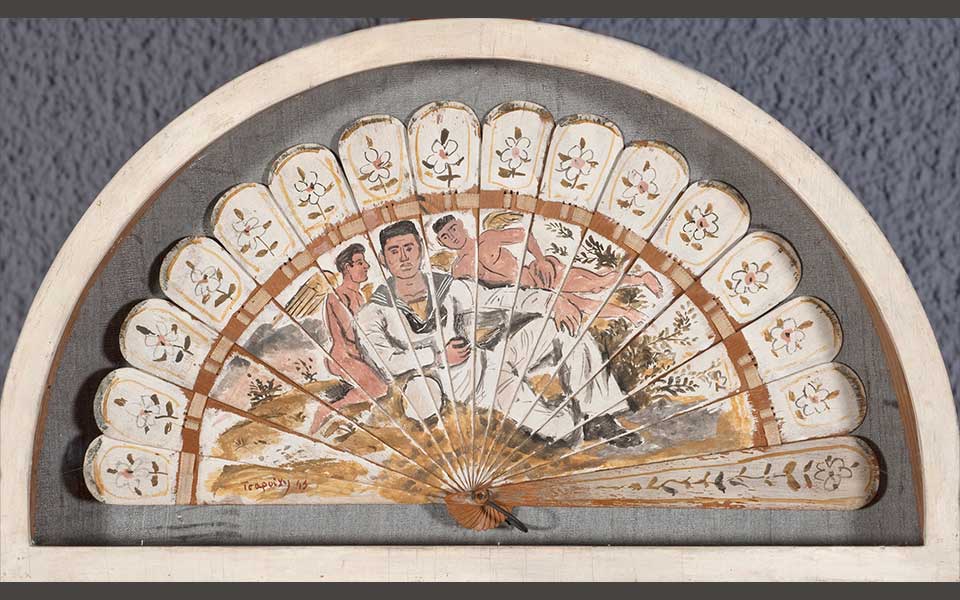
Sailor and Cupids (Fan), 1943, Yiannis Tsarouchis
Tsarouchis had a distinct way of depicting men in uniform. Some of his most well-known and finest works feature uniformed men, particularly sailors, though occasionally a police officer or soldier appears. If we were unsure how to interpret this particular sailor, whose pose is relaxed yet not overtly provocative, the cupids flanking him help provide context. These figures are far from the chubby infant putti often associated with Cupid; instead, they are winged young men in their prime, hovering on either side of the sailor, drawing the viewer’s eye with their well-defined pectorals, triceps, thighs, and glutes.
Objects of desire themselves, their wings and gentle poses highlight the innocence of the scene set in a bucolic meadow. In this case, the medium reinforces the message: the scene, with its floral border, is not painted on a canvas but rather on a fan – an inherently flirtatious personal accessory, whose motion mimics the fluttering of the cupids’ wings. Tsarouchis’ sensually charged depictions of men evoke a directness that resonates today. Viewed within the social mores of the time, this honesty sparks admiration.
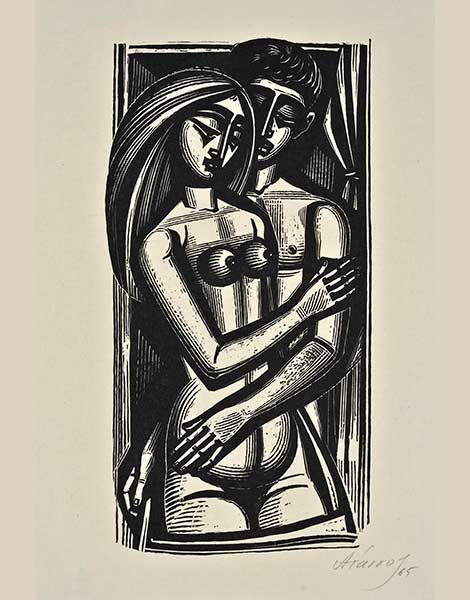
Tassos (Alevizos Anastasios), Song of Songs. Song II, 1965
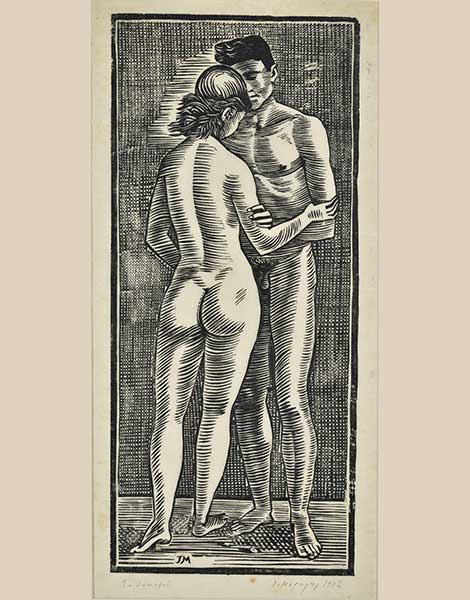
Yannis Moralis, Couple, 1942
Tassos’ woodcut of a couple in an erotic embrace offers a striking contrast to Moralis’ work. The man holds the woman from behind, and rather than conveying a moment of passion, they seem to share a deep contentment – a serene union of hearts and minds, as reflected in their aligned expressions and the perfect harmony of their noses.
One of Greece’s foremost printmakers, Tassos combined Byzantine idioms with contemporary expression. His Song of Songs series, which includes this piece inspired by Song II, features the beautiful line: “Strengthen me with raisins, refresh me with apples, for I am faint with love.”
Moralis, a master of discreet erotic expression, captures desire in the least supple of mediums: woodcut. There are no flowing curves or subtle shading; instead, strokes and cross-hatchings convey vitality and depth. The figures are beautifully posed, leaning toward each other with tenderness – heads inclined, hands lightly touching arms. This decisive moment, the understanding between them, is a consummation in itself. The small work is breathtaking, and the palpable intimacy makes one look away briefly.
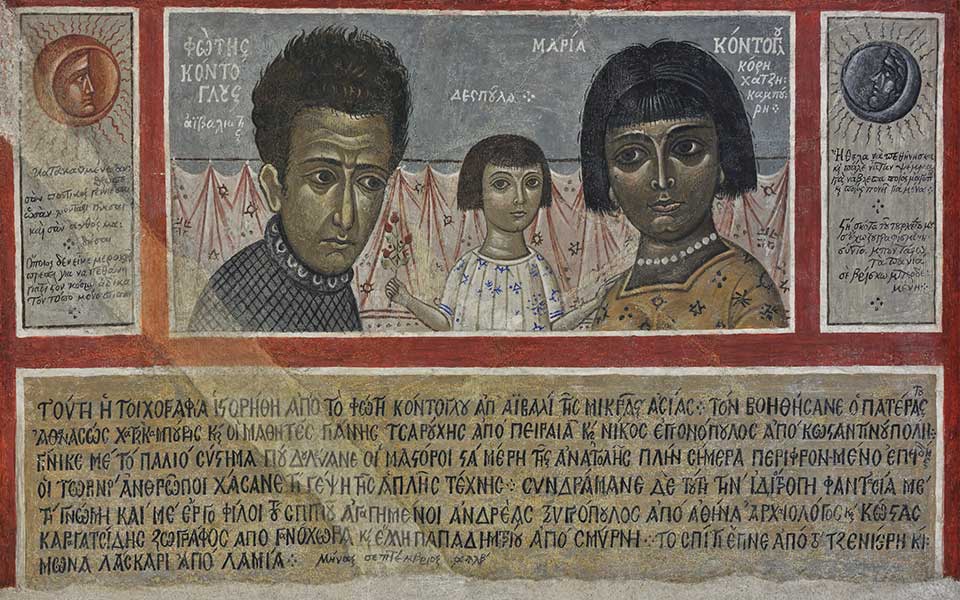
Fotis Kontoglou, Wall Painting for his home, 1932
This work alone makes a visit to the National Gallery worthwhile. Kontoglou, a master of Byzantine art, was a deeply influential figure for the “Generation of the ‘30s.” Many notable artists, including the surrealist Nikos Engonopoulos and modern painter Yannis Tsarouchis, apprenticed under him – Tsarouchis also helped paint this vast fresco on the walls of Kontoglou’s home.
The central focus of this multi-faceted work is the artist himself, flanked by his wife, Maria, and their young daughter, Despoula (Depoina), at the heart of the composition. The inscription beneath is particularly poignant, proclaiming his Asia Minor roots as a son of “Aivali” (or “Kydonia” – both names referring to “the land where the quinces grow,” in Turkish and Greek), expressing gratitude to his collaborators, and affirming his dedication to the purity of the Byzantine idiom.
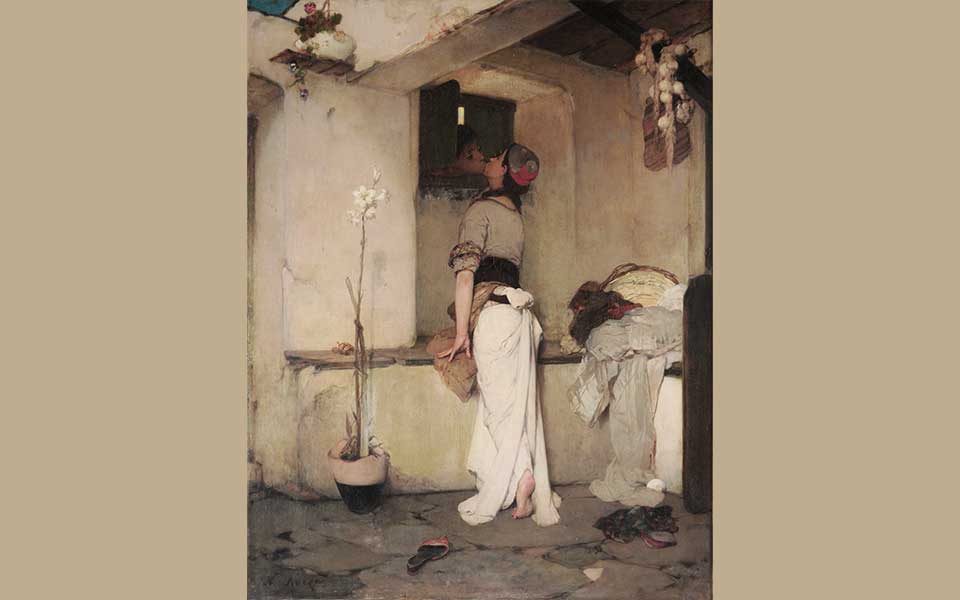
A key figure in modern Greek painting, Lytras offers a window into late 19th-century Greek society. His works divide into two distinct themes: fine portraits in the academic style for the urban elite, and pioneering genre painting of everyday Greek life. Among these, The Kiss is particularly evocative. This innocent kiss between two young people, though not passionate or lustful, is charged with sweetness.
The girl, on tiptoe, barely reaches the boy’s lips. She seems to be in a root cellar, while he crouches to meet her lips, awkwardly leaning into the ground-level window. The simplicity of the setting – laundry spilling from a basket, a braid of garlic hanging from a rafter, and a forgotten slipper – pulls the viewer right into the moment. A flower on the left may symbolize their innocence, though we would have grasped that without it.
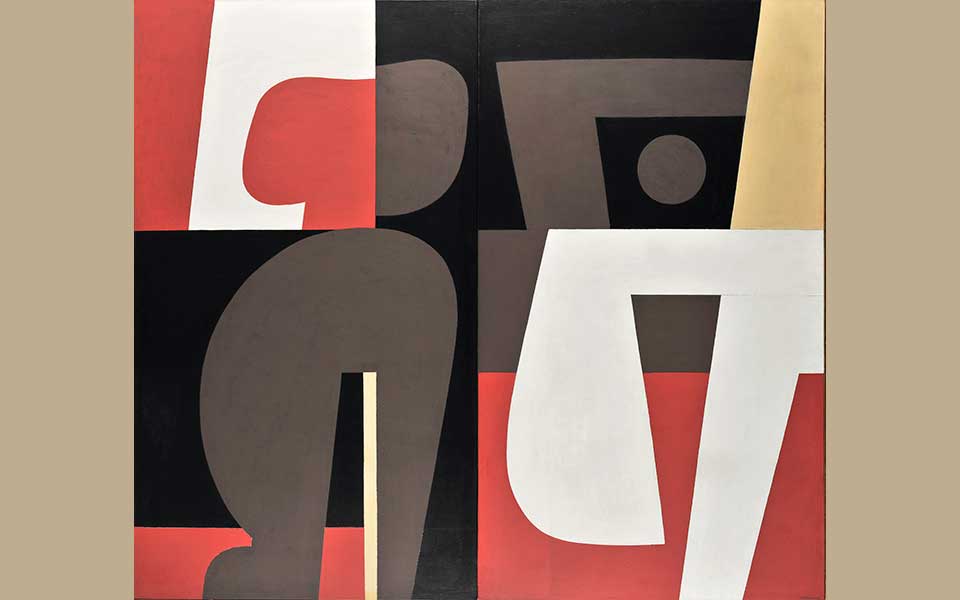
Yannis Moralis, Love Scene, 1982
To fully appreciate the development of Moralis’ work – both stylistically and thematically – it helps to view a wide range of his pieces spanning several decades, which you can do at the National Gallery. The collection is primarily displayed together (with the woodcut mentioned above included in the print section).
Here, you can trace his early figurative works and portraits, followed by the key transitional phase of stylized figures, such as in the Funeral Compositions of the late 1950s. Then, there is this remarkable abstract work – although, upon closer inspection, it isn’t truly abstract. Once again, we see two figures interacting within a dynamic composition, full of energy that justifies the painting’s title.
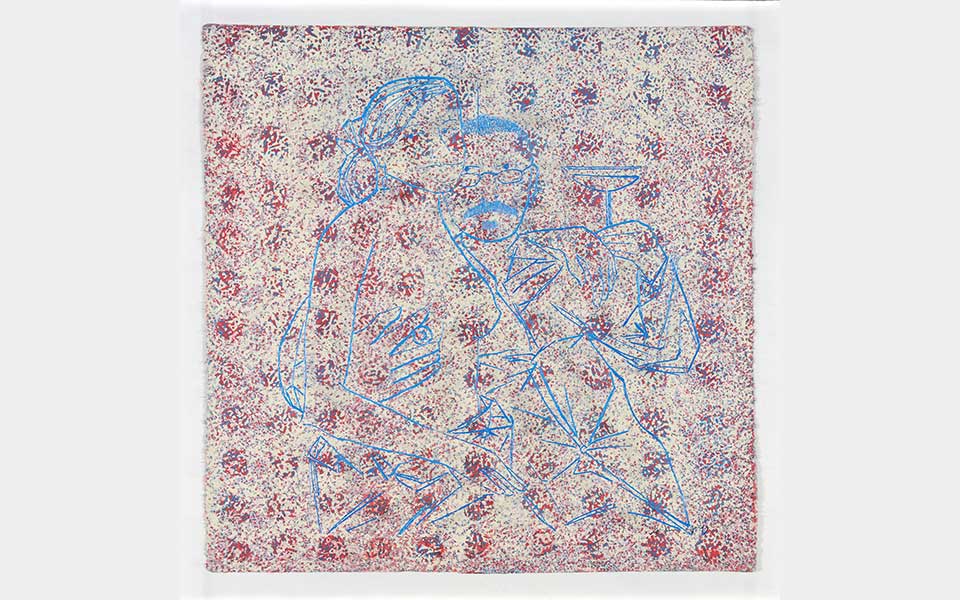
Sachinis Xenis (Xenophon), Xenis with his wife Louis Corinth, 2011
This clever, multi-layered work, both literally and figuratively, engages the viewer provocatively. A linocut on paper with pointe sèche on plexiglass, it depicts the artist with a martini glass in one hand, fondling his wife’s breast with the other.
The familiarity of the composition – reminiscent of Le Déjeuner sur l’herbe and Gabrielle d’Estrées et une de ses sœurs – adds layers of cultural reference. The background evokes a bucolic mood, while the expressive blue line sketches a narrative that is both gently erotic and sophisticated.
A Polish-born artist who lives on...
The West Wall Collective revitalizes Thessaloniki’s...
At 1,160m, Metsovo blends preserved mountain...
Illustrator Maria Pagkalou draws enchanting portraits...